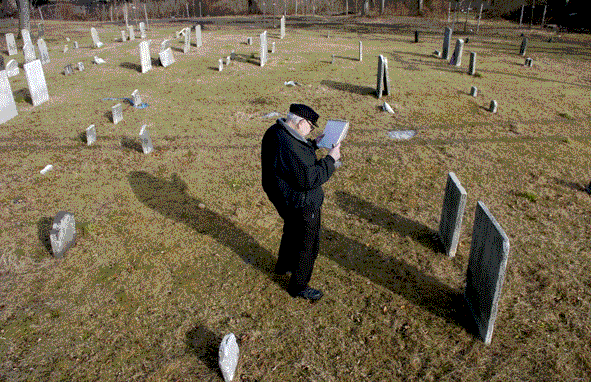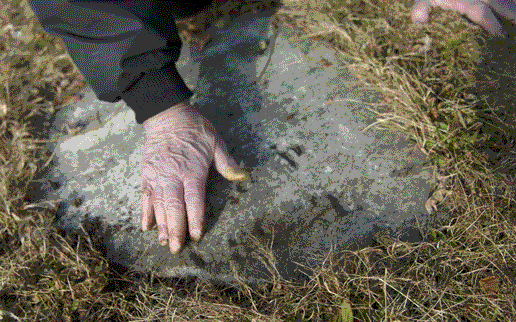The following is a story about Dick Roberts and Stamford cemeteries in the Stamford
Advocate

Dick Roberts surveys the West Stamford Cemetery at Greenwich Ave. and Richmond Ave. in Stamford earlier this month.
Kathleen O'Rourke/staff photos
Copyright © 2008,
Southern Connecticut Newspapers, Inc. |
February 17, 2008
Uncovering mysteriesBy Wynne Parry
Advocate Staff Writer
STAMFORD - A broken marble headstone lies embedded in browned winter grass. A few faded characters describe a life 53 years, two days long - the only clues left to the identity of the person beneath.
Many other headstones in West Stamford Cemetery are unreadable, their inscriptions weathered away and obscured by lichen. Some have broken off near the ground and lean against other stones; some are gone entirely, leaving their graves unmarked.
Every year, the lives of the people buried in the West Side graveyard from 1771 to 1906 slip further from memory.
Stamford has more than 40 of these old cemeteries. Some of their graves date to before the Revolutionary War through the early 20th century.
For two years, one man has been mapping and photographing these cemeteries.
On a mild February afternoon, Dick Roberts arrived at West Stamford Cemetery at Greenwich and Richmond Hill avenues. He was carrying a spiral-bound sketch pad, a camera and pages from an index of headstones assembled by the Works Progress Administration in the 1930s.
Roberts, 77, examined the toppled gray stone with the age inscription. To identify its owner, he held the index up close to his dark-rimmed glasses.
The age matched a George Smith, who died in 1849. A small footstone, which marks the end of the grave with the initials "GS," appears to confirm this identity.
Since the Revolutionary War, a paper trail exists for most residents, said Ron Marcus, librarian at the Stamford Historical Society. "But for many of them, if they didn't own property, if they died very young, if they were poor, these stones might very well be the only record of these individuals," he said.
For this reason, Roberts feels a sense of urgency in his work. "It's probably the only record anywhere of George Smith," he said of the stone. "It gets weathered away or broken and George Smith is gone."
Many others already are. WPA workers recorded many more inscriptions that Roberts can match with stones.
When he finds a new name, such as George Smith's, it goes onto his sketch below the gravestone he has drawn. He draws his final maps by hand, from an aerial perspective that includes trees, walls and notes on veterans graves.
He gives his maps and the photos he snaps of interesting stones to the historical society, where another volunteer will scan them into a computer. In time, the society plans to make Roberts' work available on its Web site.
This is his own project; Roberts does not receive compensation from the historical society.
Near George Smith, Roberts locates Rhuea Jessop's grave. Much of her inscription is gone, but he knows her as the daughter-in-law of his grandfather, five times removed. From his genealogical research, Roberts also knows a 2-month-old infant is buried with the woman who died in 1799.
This project was born out of an interest in genealogy. Roberts is descended from many of the original families in Stamford, including the Jessops.
In addition to the index, Roberts draws upon a book about poems inscribed on the city's old headstones and the city's land-use maps. He has found most known cemeteries by now, and even rediscovered one near Riverbank Road, abandoned since the 1920s and absent from all maps.
The physical demands of this work are not insignificant for someone of his age: locating the cemeteries required some door knocking and hacking through woods, he said. The challenge is evident as he struggles to his feet after kneeling before George Smith's flat stone and admonishes two visitors never to get old.
For a man of his age who spends a great deal of time in cemeteries, mortality would seem to be much on his mind.
Yet Roberts said he does not have a burial plot set aside for himself. "I'm not thinking that far ahead."

Dick Roberts wipes an old tombstone in an effort to find clues to the person's identity.
Kathleen O'Rourke/staff photos
Copyright © 2008,
Southern Connecticut Newspapers, Inc. |
Copyright © 2008, Southern Connecticut Newspapers, Inc.
All Rights reserved. Reprinted with permission.
March 10, 2008: Currently Dick Roberts has completed over thirty sites, having just finished the North Stamford Congregational Church's cemetery.
Mapping Lost Graveyards in Stamford (Richard Roberts)
Stamford Cemeteries


![]()
